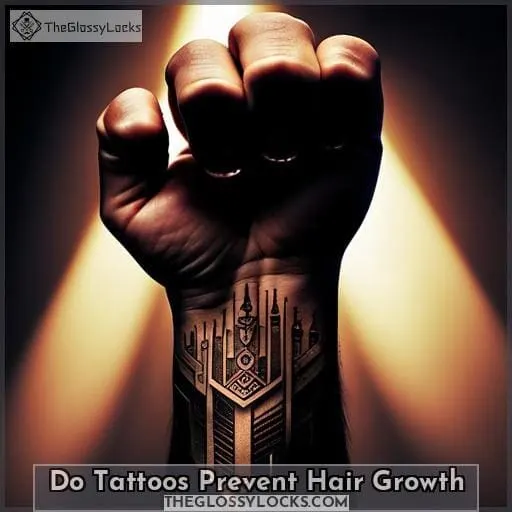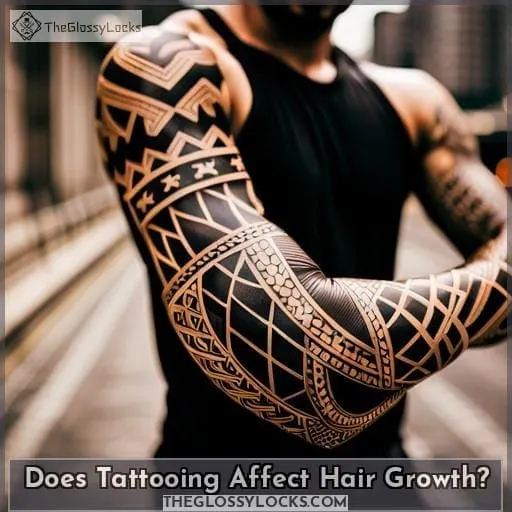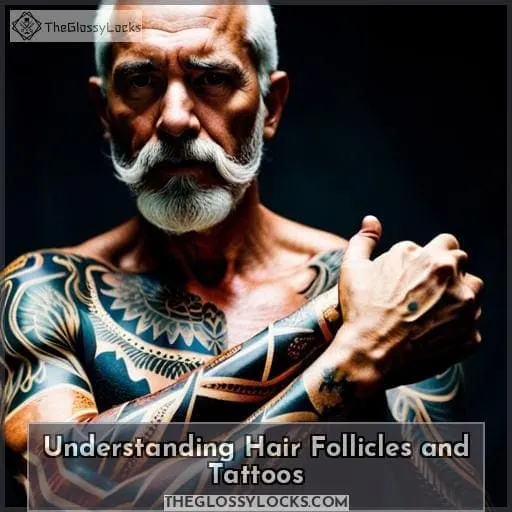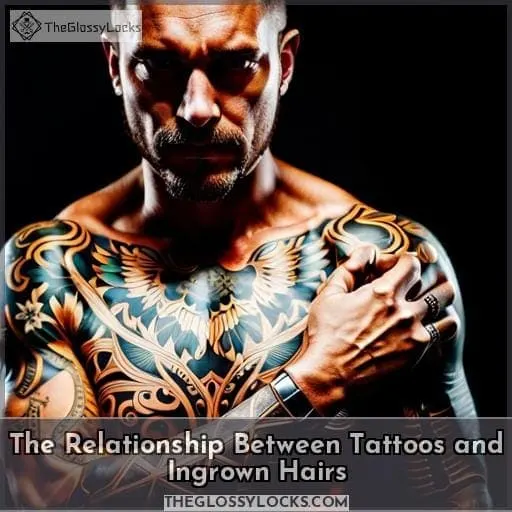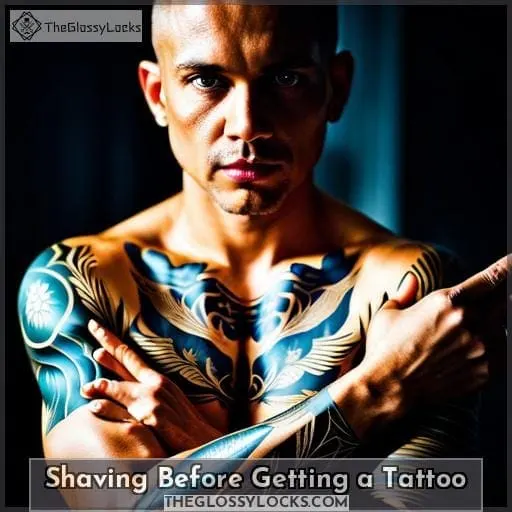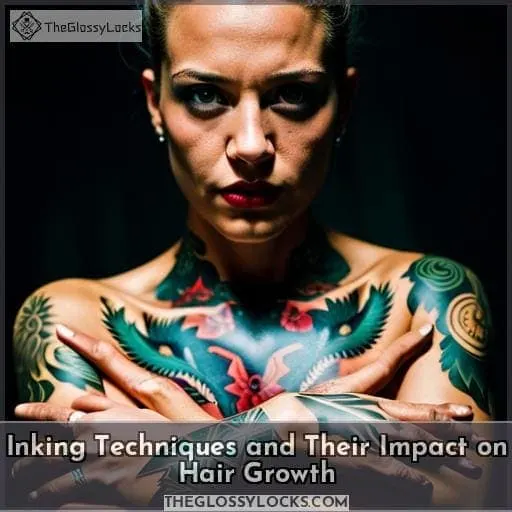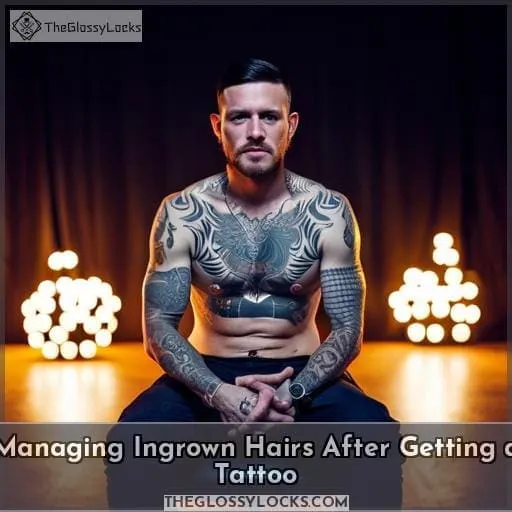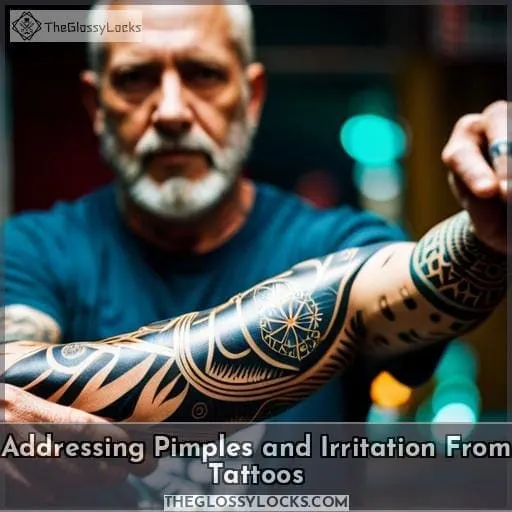This site is supported by our readers. We may earn a commission, at no cost to you, if you purchase through links.
Are you considering getting inked up? Before taking the plunge, it’s important to consider if tattoos could affect your hair growth. Do tattoos prevent hair growth or do they actually help stimulate it? We’ll explore how tattooing affects follicles and whether shaving can make a difference before getting inked.
Table Of Contents
- Key Takeaways
- Does Tattooing Affect Hair Growth?
- Understanding Hair Follicles and Tattoos
- The Relationship Between Tattoos and Ingrown Hairs
- Shaving Before Getting a Tattoo
- Inking Techniques and Their Impact on Hair Growth
- Managing Ingrown Hairs After Getting a Tattoo
- Addressing Pimples and Irritation From Tattoos
- Frequently Asked Questions (FAQs)
- Conclusion
Key Takeaways
- Tattoos do not disrupt hair follicles or impede hair growth.
- Proper aftercare routine is essential to prevent irritation, ingrown hairs, and infection.
- Selecting an experienced tattoo artist who uses appropriate techniques and equipment is crucial for a successful outcome.
- Good hygiene, skin preparation, and hydration are important for optimal cell nourishment, healing, and minimizing the risk of complications.
Does Tattooing Affect Hair Growth?
You might be wondering whether inking a design on your skin may interfere with the natural hair growth cycle, but you can rest assured that it doesn’t! Tattooing is an invasive technique and requires expertise to ensure proper pigment deposition into the dermal layer of your skin.
It does not affect or hinder hair follicles, which are located much deeper within the epidermis.
In fact, following a proper aftercare routine helps keep any irritation caused by ingrown hairs at bay – something that could have been triggered even without getting tattooed! So no matter how intricate or detailed your tattoo is, do tattoos prevent hair growth? The answer would definitely be ‘no’.
Hair grows approximately half an inch per month on average, influenced by factors like age and genetics average hair growth in a month. After all, when done properly, there shouldn’t be anything disrupting healthy cell regeneration cycles necessary for the normal growth of facial and body hairs.
Understanding Hair Follicles and Tattoos
Seeing the intricate design of your tattoo, it’s important to understand how it relates to the complex structure of hair follicles beneath your skin.
Hair follicles are located deep in the dermis layer and consist of a variety of epidermal cells that work together for proper growth. Tattooing is an invasive technique with pigment deposited into this same layer; however, it does not interfere with hair growth when done correctly.
Taking proper care during placement and selecting ink types that will minimize scarring risks can help ensure a successful healing process without disruption to healthy cell regeneration cycles essential for normal facial or body hair growth.
Additionally, avoiding excessive contact or irritation around the area helps prevent ingrown hairs which may be caused by any number of factors including tattoos but should never be confused as directly related since they do not obstruct healthy new strands from growing in their place!
The Relationship Between Tattoos and Ingrown Hairs
With proper care and placement, your tattoo can coexist in harmony with existing hair follicles without causing ingrown hairs. To protect the skin during the inking process, use ink types that minimize scarring risks and ensure a successful healing period.
During this time, make sure to avoid excessive contact or irritation around the area as it may lead to developing ingrown hairs.
Here is a list of tips for keeping healthy follicle roots:
- Follow proper tattoo aftercare instructions.
- Maintain correct ink techniques.
- Cleanse gently but thoroughly at least twice daily.
- Keep hydrated by drinking plenty of water.
- Avoid any type of hair removal near the area.
The key is understanding how tattoos interact with our body’s natural functions so that we can enjoy them safely while preserving our personal style! With careful consideration given towards these points when getting a permanent design, you’ll be able to maintain beautiful artwork on your skin without worrying about hindering its growth potentials!
Shaving Before Getting a Tattoo
It’s wise to shave the area where you plan to ink your masterpiece before getting tattooed – and not just for aesthetic reasons! Shaving the area beforehand has several benefits, especially when it comes to aftercare and skin care.
By removing any hair in that specific spot, you create a clean canvas for the tattoo artist, allowing them better visibility and precision during the inking process. Additionally, shaving helps prevent any potential irritation or discomfort caused by hair pulling during healing.
It also facilitates better application of ointments or creams recommended for post-tattoo care without interference from surrounding hairs.
However, it’s important to note that shaving should be done carefully using proper techniques and tools to avoid cuts or nicks on the skin surface which can expose it to infections or other complications.
| Benefits of Shaving Before Getting Tattooed | Aftercare Tips | Skin Care |
|---|---|---|
| Allows cleaner application of tattoo | Follow proper instructions | Cleanse gently but thoroughly |
| Facilitates precise work | Use appropriate ointments | Stay hydrated |
Remember that maintaining good hygiene is crucial throughout this process. Following these tips will help ensure both your safety and satisfaction with your new ink: prepare yourself properly by taking necessary precautions such as cleaning regularly while preserving moisture levels within cells; wear loose clothing until fully healed so as not to hinder airflow around wound areas (which aids healing); do not pick at scabs since they are essential barriers protecting fresh layers underneath; minimize exposure to direct sunlight to protect colors from fading away prematurely due to UV radiation damage inflicted upon pigmentation molecules residing in the dermis layer below the epidermis surface!
By adhering closely to these guidelines and implementing them diligently into routine practice, a long-term commitment towards a successful outcome is guaranteed every time one chooses to undertake the beautiful artwork journey of personal liberation and empowerment through tattoos!
Inking Techniques and Their Impact on Hair Growth
Undergoing the art of inking, you should be aware that it may affect hair growth depending on the techniques used. In general, tattoos do not prevent or impede hair growth; however, there are certain aspects of tattooing that can potentially cause skin irritation and impact follicles.
To ensure a successful outcome while preventing any undesired side effects such as ingrown hairs or skin damage, proper aftercare is essential following each session.
Additionally, take precaution when selecting an artist who utilizes appropriate techniques with their equipment – needle depth settings must be adjusted based on an individual’s body composition in order to achieve desired results without causing unnecessary trauma, which could lead to adverse reactions like scabbing or swelling at later stages!
Finally, make sure not only to follow all post-tattoo instructions given by a professional artist but also to listen carefully to what they have to say about risks associated with the procedure itself.
This way, if anything does happen during the healing process, you’ll know how best to deal with it quickly without compromising the end result.
Managing Ingrown Hairs After Getting a Tattoo
After getting inked, you may experience ingrown hairs, which can cause inflammation and discomfort. To prevent this, it’s important to assess your skin type and the quality of ink used for the tattoo before committing to a design.
Depending on how sensitive your skin is or what hair type you have (fine/coarse), certain techniques may be more suitable than others.
Additionally, make sure to properly care for and maintain your tattoo after each session. Keep hydrated by drinking plenty of water throughout your day-to-day life and use moisturizing products if necessary.
Finally, opt for higher quality inks when possible. These are typically made from plant extracts, which promote better absorption into dermal layers without causing too much trauma or damage at later stages.
Taking all these precautions seriously will ensure a successful outcome in terms of both aesthetics and comfort.
Addressing Pimples and Irritation From Tattoos
You may experience pimples or discomfort around your inked area due to irritation, so it’s important to take proper aftercare of the tattooed skin.
Skin preparation is essential before getting any type of ink placed on the body as tattoos can be susceptible to infections. To avoid this, make sure that you properly clean and exfoliate the area where you plan on placing a tattoo prior to inking sessions.
Additionally, consider avoiding areas with thicker layers of fat or muscle if possible since these are more likely prone for infection-causing bacteria buildup during healing processes.
When it comes down to choosing an artist for your desired design, look into their portfolio and research how they execute techniques such as shading and line work when creating custom pieces. This will help determine whether they’re experienced enough for optimal results without compromising safety standards throughout procedure stages.
Finally, be aware that some pigment colors can cause more sensitivity than others.
Frequently Asked Questions (FAQs)
What are the risks associated with getting a tattoo?
Glorify your body with a tattoo, but be aware of the risks. It may cause inflammation and discomfort from ingrown hairs. Pimples can occur if the area is irritated too much. Proper aftercare in those first 24-48 hours is important for healing and avoiding infection.
Are there any health benefits to getting a tattoo?
Getting a tattoo can be beneficial for your health. It helps to boost self-esteem, reduce stress and anxiety levels, and strengthens self-identity. Tattoos also provide an opportunity for creative expression while showcasing individual style.
Finally, tattoos can act as a reminder of meaningful moments or relationships in life that you want to honor forever.
Does getting a tattoo hurt?
Getting a tattoo can be uncomfortable and even painful at times, but the sensation is often described as bearable. Many people find that their skin becomes numb after a few minutes of inking, allowing them to power through the process with poise and perseverance.
Is it safe to get a tattoo during pregnancy?
Pregnant women should be cautious when getting tattoos as the risks are unknown. However, it is possible to get tattoos with precautions and care. Sterilization of equipment and proper aftercare can minimize any potential danger for mother or baby.
How long does it take for a tattoo to heal?
The healing process of a tattoo can vary, but generally, it takes around 4-6 weeks for the skin to fully heal. During this time, proper aftercare is important in order to avoid infection and keep your tattoo looking vibrant.
Avoid touching or irritating the area excessively and keep it clean with soap and water regularly.
Conclusion
In conclusion, tattoos can be a beautiful way to express yourself without disrupting the natural growth of hair. While it is possible for ingrown hairs to occur, proper tattoo aftercare and good hygiene practices can help reduce the risk.
With the right artist and a little bit of patience, you can achieve a tattoo that looks great and won’t impede your hair growth in any way. Even if you’re a bit nervous about the process, rest assured that the end result can be absolutely stunning – almost too good to be true.

